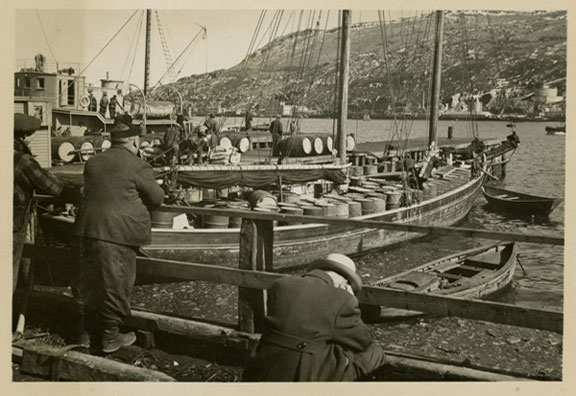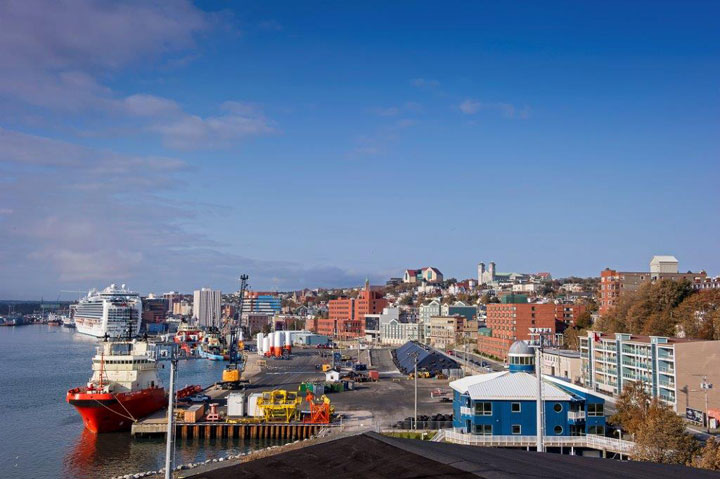More than 500 years in the making, St. John’s has become one of the most beautiful and incredible oceanside cities in the world. St. John’s Port Authority began operations in 1965…
The view of the harbour from the peak of Signal Hill is a proper spot from which to reflect upon the history of the Port of St. John’s. Standing at a great height above the town, one can appreciate each of the unique geographical features of the port as well as visualize the small town as it was in the days of its bare beginnings. Stripping away the modern harbour-front architecture, one can picture sixteenth century visitors to St. John’s veering their vessels into a series of uninhabited coves. Beyond these coves and onto the land, lay an elevating expanse of meadows later known as “The Barrens.” As settlement grew in the town, these coves would eventually acquire names – Beck’s Cove, Ayre’s Cove, Steer’s Cove-each reflecting the early merchant firms that established businesses there.

Photo Credit: The Rooms Provincial Archives
Slyly secluded behind dangerous curtains of rock and fog, the harbour might easily be overlooked by vessels passing by. The entrance to the harbour is narrow, shallow and treacherous, easily navigable by local fisherman and sailors, but posing a demanding obstacle for foreign-going vessels, one that proved a valuable asset during the numerous military contests to claim ownership of the port. Once inside The Narrows, the scene changes dramatically. In contrast to the final approach towards the harbour, the port is calm, and bitter winds are blunted considerably by the Southside Hills, a military defense in their own right. Over the years the port has proven small enough to provide shelter and security, yet large enough to accommodate some of the world’s largest vessels, becoming a major hub for the province’s most prominent and busiest industries.

Photo Credit:St. John’s Port Authority
In the fifty years since the port’s incorporation under the National Harbours Board of Canada, the Port of St. John’s has undergone remarkable change. Within the past three decades, the port has managed to reinvent itself as a major base for the oil industry, a remarkable transformation for a port that credited its existence to the salt fish trade for five centuries. The gradual decline of various fisheries around the island saw the replacement of annual traditions with new ones. For years the port had hosted the arrival and departure of the spring seal fishery, which brought men from all over the island to the harbour-front in hopes of securing a berth at sea. Fishermen from all over the world relied upon the Port of St. John’s as the only safe haven in the North Atlantic, and many foreign sailors became intimately acquainted with the people and geography of St. John’s. In particular, the annual visit of the Portuguese White Fleet helped strengthen a special cultural relationship that is still nurtured today. For centuries of seaman who worked on these frigid waters, the port was their St. John’s.

Photo Credit: J.P Andrieux
Certainly, for the first centuries of settlement in St. John’s, the harbour was the undisputed focal point of the town. The harbour was the means by which the town’s first wealth was attained, providing an access point to the salt cod fishery. Given that the first paved road across the island was not completed until 1965, this port served as the only transportation link to the outside world for many Newfoundlanders. Today, the Port of St. John’s has reinvented itself into more than just a shipping terminal supplying the entire island, but also as a major oil supply base in the North Atlantic.

Photo Credit: St. John’s Port Authority
Many of the infrastructural upgrades made to the Port of St. John’s ushered in a new era of innovation and efficiency in the world of trans-continental shipping. Before Harbour Drive was completed in 1965, the north side of the harbour was lined with finger piers jutting out into the harbour. These wharves were privately owned by the numerous merchant firms that were lucky enough to claim what little waterfront property existed. These firms exported codfish internationally, and received imported goods to be shipped around the island or sold through retail stores on Water Street. Goods were loaded and unloaded using a gang system of longshoremen, with cargo moved by hand to and from storage sheds located on the waterfront. The outbreak of WWII in 1939 helped illuminate the inefficiency of the archaic finger pier system, when the harbour quickly became a haven for convoys of massive warships that crowded the harbour alongside the traditional schooners. The arrival of American and Canadian servicemen created an unprecedented level of bustle in the tiny port. Wartime activity meant that a wider range of consumer goods was available and thus in demand. As in other centres, the Port of St. John’s gradually adopted the use of standardized shipping containers to send and receive goods. Containerization had a tremendous impact on the nature of the work done by longshoremen at the port.

Photo Credit: The Rooms Provincial Archives

Photo Credit: St. John’s Port Authority
This project tells the story of daily work patterns and routines that are quickly vanishing, if they have not already done so. Those who have grown up in close proximity to the harbour may recall seeing gangs of stevedores moving loose cargo, or hoards of fishermen working frantically to unload catches and supplies. Gradual industrial change, coupled with technological innovations in the oil and shipping industries have significantly impacted the types of jobs that port workers do, causing a decrease in the amount of human labour in ports all over the world. Technology has allowed us to reach unprecedented levels of productivity and efficiency. But machines cannot talk. They are not members of the community. They do not have memories, or families, or the ability to tell stories. It is fitting, then, that the legacy of our port is commemorated through the telling of these stories. Through them, the survival of that legacy is ensured.
“From my bedroom window…you could see most of the harbour. And from the kitchen, you could see the Southside. If I had a set of binoculars…I could see dad on the waterfront. That was my St. John’s.”
–
Glenn Critch
Like Newfoundland itself, the Port of St. John’s is most defined not by its natural features, but by the people who have worked there and called it home over the past five centuries. Ports are fascinating places partly because, by their very nature, they are a blend of occupations and cultures interacting daily, monthly and yearly. Although firmly embedded in the heart of the city, a port operates much as its own town, a unique cultural organism. Combine these elements with the unique linguistic and cultural flavour of Newfoundlanders, and it is no wonder why the Port of St. John’s has managed to develop such a distinct character.

Photo Credit: St. John’s Port Authority
